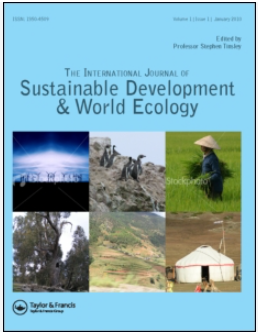孟加拉国气候敏感沿海地区家庭粮食安全状况及其驱动因素:暴露海岸与内陆海岸的比较
IF 7.7
3区 环境科学与生态学
Q1 ECOLOGY
International Journal of Sustainable Development and World Ecology
Pub Date : 2022-09-19
DOI:10.1080/13504509.2022.2123409
引用次数: 0
摘要
气候变化威胁着沿海地区人民的生计和粮食安全,沿海地区的农业面临着独特的挑战。因此,家庭粮食安全仍然是一个主要问题,特别是在孟加拉国气候敏感的沿海地区。本研究比较了孟加拉国外露海岸和内陆海岸的粮食安全状况,并确定了影响家庭粮食安全的因素。来自6个沿海地区的750户家庭(外露海岸375户和内陆海岸375户)接受了调查。采用食品消费评分(FCS)、描述性统计和一套计量经济模型来实现目标。在受辐射的沿海地区,约有20%的家庭处于FCS的边缘类别。内陆沿海家庭的FCS显著高于外露沿海家庭。分析结果显示,每公斤大米价格每上涨1美元,将使进入粮食安全类别的可能性降低40%以上。在内陆和沿海地区,从事农场园艺的家庭处于食品安全类别的可能性分别高出4.30%和9.15%。在暴露的沿海地区,获得信贷使食品安全类别的可能性增加了7.15%。与经济地位相关的因素,如较高的农业和非农业收入,也增加了这两个沿海地区粮食安全的可能性。为了改善沿海地区家庭一级的粮食安全,有必要采取因地制宜的可持续耕作方式、提供非农业就业机会、稳定大米价格、开展农业培训和提供资金。本文章由计算机程序翻译,如有差异,请以英文原文为准。
Status and drivers of households’ food security status in climate-sensitive coastal areas of Bangladesh: A comparison between the exposed and interior coasts
ABSTRACT Farming in coastal areas has unique challenges as climate change threatens coastal people’s livelihoods and food security. Therefore, household food security remains a major concern, especially in Bangladesh’s climate-sensitive coastal districts. This study compared the food security status and identified the factors influencing households’ food security in the exposed and interior coasts of Bangladesh. A total of 750 households (exposed coast: 375 and interior coast: 375) were surveyed from six coastal areas. The Food Consumption Score (FCS), descriptive statistics, and a set of econometric models were used to achieve the objectives. Around 20% of households in the exposed coast were in the borderline category of FCS. The FCS of the interior coast households was significantly higher than the exposed coast households. The analysis results revealed that a 1 USD increase in the price of rice per kg would decrease the likelihood of being in the food secure category by more than 40%. Households who engaged in homestead gardening had a 4.30% and 9.15% higher likelihood of being in the food secure category in the interior and exposed coasts, respectively. Access to credit increased the likelihood of being in the food secure category by 7.15% in the exposed coast area. Economic status-related factors, such as higher farm and non-farm incomes, also increased the likelihood of being food secure in both coastal areas. To improve the household-level food security in coastal areas, location-specific sustainable farming practices, non-farm employment opportunities, rice price stabilization, agricultural training, and capital availability are warranted.
求助全文
通过发布文献求助,成功后即可免费获取论文全文。
去求助
来源期刊
CiteScore
11.10
自引率
3.60%
发文量
58
审稿时长
18-36 weeks
期刊介绍:
The International Journal of Sustainable Development and World Ecology is now over fifteen years old and has proved to be an exciting forum for understanding and advancing our knowledge and implementation of sustainable development.
Sustainable development is now of primary importance as the key to future use and management of finite world resources. It recognises the need for development opportunities while maintaining a balance between these and the environment. As stated by the UN Bruntland Commission in 1987, sustainable development should "meet the needs of the present generation without compromising the ability of future generations to meet their own needs."

 求助内容:
求助内容: 应助结果提醒方式:
应助结果提醒方式:


